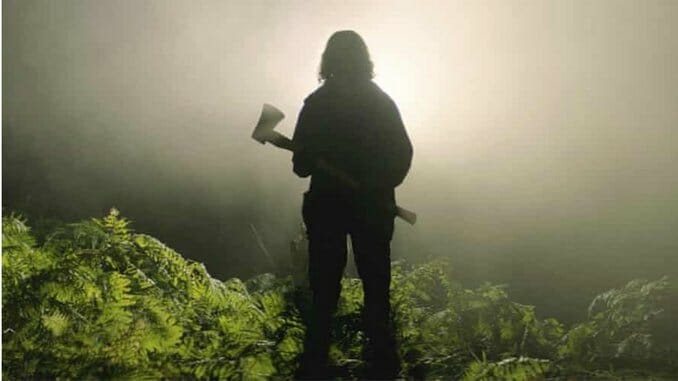Ben Wheatley’s In the Earth Falters While Pushing His Limits
(Sundance 2021)
Movies Reviews Ben Wheatley
In 2019, Ben Wheatley took a holiday from making Ben Wheatley movies and worked on Netflix’s remake of Alfred Hitchcock’s Rebecca, which elicited less-than-enthusiastic reactions when the streaming service released the film last September. In 2020, while all of us sat indoors obsessively washing our hands and binging everything on Netflix except for Rebecca, Wheatley went and shot a new movie, ominously titled In the Earth, in a hair over two weeks. Think of this project in two ways: As his attempt to move past the coronavirus outbreak instead of burrowing into it, as other movies made in this moment tend to, and as a return to his roots as a micro-budget horror filmmaker.
With little more in his back pocket than a quartet of talented actors, a whole catalog of camping gear, and bottomless ingenuity, Wheatley evokes our current insane predicament without gracelessly mirroring it, telling a pandemic tale that’s both a clear product of its time and so delicately shaded that it’s nevertheless timeless. The film speaks to the moment while speaking to the unimpeachable dread of life under duress from contagion, and maybe the presence of old forest-dwelling pagan gods.
Imagine Wheatley’s best movie, the hitman-meets-cult-meets-ultraviolence picture Kill List, with his second best movie, the 17th century acid freakout A Field in England, tacked onto the backend, and that’s about the circumference of In the Earth. The problem is that Kill List and A Field in England have only a distant relationship despite having the same father: The former is grounded in the territory of the Antichrist by way of Wicker Man while the latter pantomimes drug-induced hallucination so well that it’s practically a drug-induced hallucination unto itself. In the Earth tries to have it both ways, an exercise that sounds fun on paper but winds up frustrating in practice.
The film’s anchor is Martin Lowery (Joel Fry), a scientist researching the mycorrhizal network of tree roots and fungi controlling the woods beyond the edges of Gantalow Lodge, kinda like a giant verdant brain. He’s venturing into the wilderness for other reasons, too: His mentor, Olivia Wendle (Hayley Squires), went missing while out on a trek of her own, and Martin means to find her with the help of Alma (Ellora Torchia), his guide through the forest. Wheatley commences his low-fi festivities with an immediate sense of dread, as if the region’s atmosphere is saturated with nihilism and foreboding, and heightens that ominous tension with a grim bread crumb trail, like an abandoned tent clearly pitched by a family, judging from the children’s toys left at the scene. There’s no easier way to suck the breath out of a viewer than the hint of imperiled little ones, especially when preceded by vague talk of an ancient forest spirit that’s apparent hostile toward them.
Whether fact or folktale, mere mention of this entity hangs over In the Earth as Martin and Alma venture through the woods on a two-day hike to Olivia’s campsite. With minimal resources at his disposal, Wheatley keeps things simple on screen and relies on smart camerawork and an unnerving soundtrack to suggest a supernatural presence: His cinematographer, Nick Gillespie, shoots at a distance, as if the trees and brush are observing Martin and Alma’s every step with sinister intent, while Clint Mansell’s score sends unnerving synth vibes creeping and crawling through the ear. According to Wheatley in the Sundance Q&A, Mansell wired up plants and captured their sounds as the foundation of his work, a stroke of mad genius to prove that ingenuity always tops funds.
But nothing here tops Reece Shearsmith, whose unhinged performance as Zach, a hermit Martin and Alma stumble upon along their journey, helps hold In the Earth together before the staged madness in the climax, where the plot grows unendurably muddled. As played by Shearsmith, Zach’s a deranged hoot: Most of the film’s gore comes courtesy of his ministrations, and for a maniac living isolated from society he’s also dryly, casually hilarious. After spending so much time fearing the intangible, his appearance, impassive but twitchy at the same time, gives the audience a solid-bodied menace to blanche at, which makes the film’s devolution into trippy incomprehensibility outright disappointing.
More filmmakers should follow Wheatley’s example, pushing their own limits as well as the limits imposed on them by COVID-19 instead of submitting to them. With In the Earth, Wheatley hits a brick wall, but he hits it hard enough that whether one sees the film as successful or not, the effort remains admirable. On the positive end, this experiment bears out Wheatley’s affinity for lesser-known actors, and suggests that his genre instincts are sharper in a stripped-down setting. But it also suggests that structure matters, and that more freedom doesn’t necessarily mean greater clarity in storytelling. Maybe a “madman chases people over hill and dale” movie is beneath Wheatley’s purview, but when writing and shooting on a tight timeline during the century’s most hellish year on record, maybe keeping it simple is best.
Director: Ben Wheatley
Writer: Ben Wheatley
Starring: Joel Fry, Ellora Torchia, Reece Shearsmith, Hayley Squires
Release Date: January 29, 2021 (Sundance)
Bostonian culture journalist Andy Crump covers the movies, beer, music, and being a dad for way too many outlets, perhaps even yours. He has contributed to Paste since 2013. You can follow him on Twitter and find his collected work at his personal blog. He’s composed of roughly 65% craft beer.